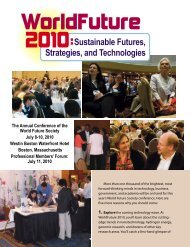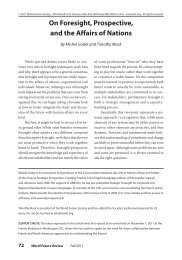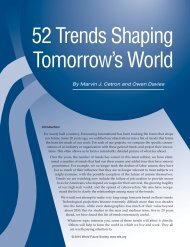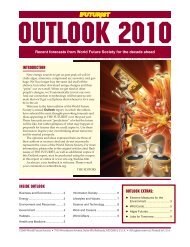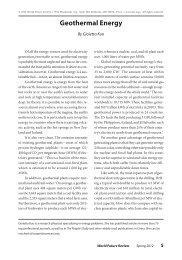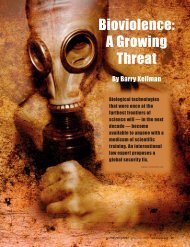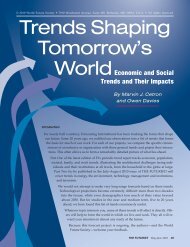Urgent Warnings, Breakthrough Solutions, Second Edition
Urgent Warnings, Breakthrough Solutions, Second Edition
Urgent Warnings, Breakthrough Solutions, Second Edition
You also want an ePaper? Increase the reach of your titles
YUMPU automatically turns print PDFs into web optimized ePapers that Google loves.
S S S S S S Plan B Budget S S S S S S<br />
Goal<br />
Funding<br />
(billion dollars)<br />
Basic Social Goals<br />
Universal primary education 10<br />
Eradication of adult illiteracy 4<br />
School lunch programs 3<br />
Aid to women, infants, preschool children 4<br />
Reproductive health and family planning 21<br />
Universal basic health care 33<br />
Total 75<br />
Grand total 185<br />
U.S. Military Budget 661<br />
Plan B Budget as share of this 28%<br />
World Military Budget 1,522<br />
Plan B Budget as share of this 12%<br />
Source: Military from SIPRI; other data at www.earth-policy.org.<br />
Goal<br />
Funding<br />
(billion dollars)<br />
Earth Restoration Goals<br />
Planting trees 23<br />
Protecting topsoil on cropland 24<br />
Restoring rangelands 9<br />
Restoring fisheries 13<br />
Stabilizing water tables 10<br />
Protecting biological diversity 31<br />
Total 110<br />
S S S S S S S S S S S S S S S S S S S<br />
seems like a reasonable goal. Since<br />
this costs roughly $2 billion in the<br />
United States, which has one-eighth<br />
of the world’s cropland, the total for<br />
the world would be $16 billion annually.<br />
The second initiative on topsoil<br />
consists of adopting conservation<br />
practices on the remaining land that<br />
is subject to excessive erosion—that<br />
is, erosion that exceeds the natural<br />
rate of new soil formation. This initiative<br />
includes incentives to encourage<br />
farmers to adopt conservation<br />
practices such as contour farming,<br />
strip cropping, and, increasingly,<br />
minimum-till or no-till farming.<br />
These expenditures in the United<br />
States total roughly $1 billion per<br />
year. Assuming that the need for erosion<br />
control practices elsewhere is<br />
similar to that in the United States,<br />
we again multiply the U.S. expenditure<br />
by eight to get a total of $8 billion<br />
for the world as a whole. The<br />
two components together—$16 billion<br />
for retiring highly erodible land<br />
and $8 billion for adopting conservasoil<br />
formation or below has two<br />
parts. One is to retire the highly<br />
erodible land that cannot sustain cultivation—the<br />
estimated one-tenth of<br />
the world’s cropland that accounts<br />
for perhaps half of all excess erosion.<br />
For the United States, that has meant<br />
retiring nearly 35 million acres. The<br />
cost of keeping this land out of production<br />
is close to $50 per acre. In total,<br />
annual payments to farmers to<br />
plant this land in grass or trees under<br />
10-year contracts approaches $2<br />
billion.<br />
In expanding these estimates to<br />
cover the world, it is assumed that<br />
roughly 10% of the world’s cropland<br />
is highly erodible, as in the United<br />
States, and should be planted in<br />
grass or trees before the topsoil is<br />
lost and it becomes barren land. In<br />
both the United States and China,<br />
which together account for 40% of<br />
the world grain harvest, the official<br />
goal is to retire one-tenth of all cropland.<br />
For the world as a whole, converting<br />
10% of cropland that is<br />
highly erodible to grass or trees<br />
tion practices—give an annual total<br />
for the world of $24 billion.<br />
Altogether, then, restoring the<br />
economy’s natural support systems—reforesting<br />
the Earth, protecting<br />
topsoil, restoring rangelands and<br />
fisheries, stabilizing water tables,<br />
and protecting biological diversity—<br />
will require additional expenditures<br />
of just $110 billion per year. Many<br />
will ask, Can the world afford these<br />
investments? But the only appropriate<br />
question is, Can the world afford<br />
the consequences of not making<br />
these investments?<br />
❑<br />
About the Author<br />
Lester R. Brown is president<br />
of Earth Policy Institute and<br />
author of World on the Edge:<br />
How to Prevent Environmental<br />
and Economic Collapse<br />
(W.W. Norton & Company,<br />
2011), from which this<br />
article was adapted with permission. He<br />
may be contacted at Earth Policy Institute,<br />
1350 Connecticut Avenue, N.W., Suite 403,<br />
Washington, D.C. 20036. Web site www<br />
.earth-policy.org; e-mail epi@earth-policy.org.<br />
<strong>Urgent</strong> <strong>Warnings</strong>, <strong>Breakthrough</strong> <strong>Solutions</strong> 29




